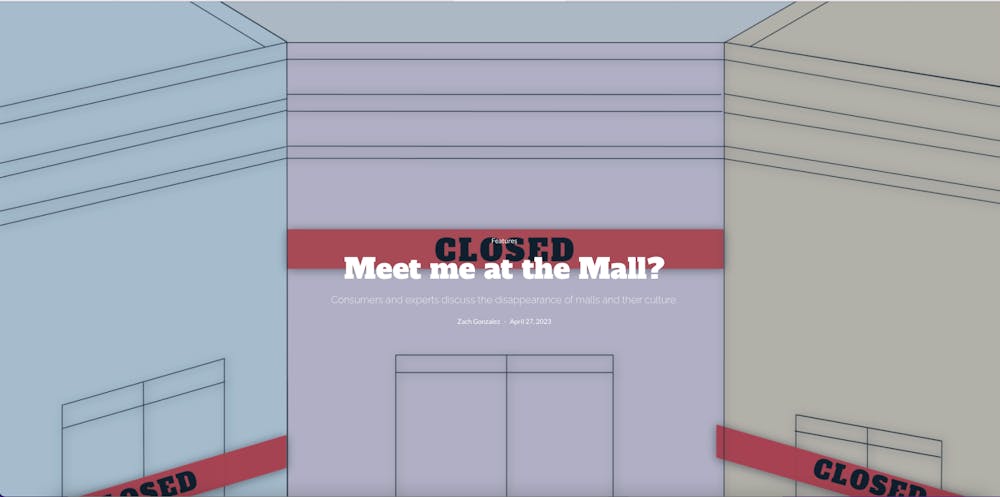As online shopping expands, malls are decreasing in number and slowly becoming extinct. According to the Federal Reserve Bank of Richmond the number of malls in the country has dropped from 1,500 in 2005 to 1,150 today. The Muncie Mall is being auctioned for a sheriff’s sale.
While the future of the mall remains uncertain, the culture of malls in general is not what it once was. Malls have served as vital landmarks for shopping for a variety of clothes and other items but are steadily regressing into a dying breed in the retail industry.
For some people, malls used to be a place for wallets to run dry through buying products with agreeable deals, and for others, a place to relax and eat at the food court. For Assistant Professor of Emerging Media Design and Development Josh Fisher, malls became settings for adventure and socializing with others.
Josh self-proclaims himself as a “mall rat,” which according to the Oxford English Dictionary, describes a young person who commonly hangs out at a mall to socialize. But being a mall rat was not shopping constantly, but rather loitering around malls and looking for an entertaining experience throughout each visit.
During Josh’s teenage years when he lived in the suburban city of Highland Park, Illinois, he spent much of his free time socializing with friends in the Northbrook Court shopping mall, with little adult supervision.
From playing games such as tag and hide and seek, to chilling at the food court, Northbrook Court was alive with energy and community compared to a suburban life Josh saw as at times boring.
“It was always busy, it was always lively, you know, like the suburbs can be a pretty sleepy place,” Josh says, “The mall was not sleepy; the mall was hopping … and it was a place where you’d meet people.”
During a time when electronic devices weren’t as commonly used for communicating with others, places like the Northbrook Mall imposed social interaction for Josh and other visitors of the mall.
“You’d meet people … and all of a sudden there’s a flirtatious back and forth, and now you’re excited to go to the mall to maybe see that girl or guy from two suburbs over who just happened to also use the mall as their hangout spot,” Josh says. “There were no tools at the time to facilitate that, it was the places that facilitated it.”
Even though Josh had friends he already knew to hang out with, he also met numerous other adolescents from different, surrounding areas in a mall he viewed as the “social epicenter of the suburbs.”
“You … never knew what the social dynamics and chemistry of the group would, like, result in that evening,” Josh says. “Would we be kicked out of the AMC for playing truth or dare and sprinting up and down the stairs and causing a ruckus, or be at the food court sharing frozen yogurt with a group of girls from a suburb over?”
Spending time at Northbrook Court was different from modern activities today, where everything appears to be scheduled.
“I missed the immediacy of everybody being in one spot and the commitment to just hang,” Josh says. “So much of adult friendships are doing a thing, and that’s not what the mall was…it was to go and just be present with one another, … and that’s certainly harder to capture these days.”
While the mall itself might still exist, the freedom of exploring a location where a wide range of possible scenarios can occur is an aspect of mall culture Josh feels was left in the past.
“I don’t see mall rats at a mall anymore; I see people shopping like they’re there with an intention, or I see people going to the restaurant,” Josh says. “It’s a place where … older people like myself will go to walk around, but it’s not the same…it’s not ‘let’s go hang and see what happens’.”
Josh believes one thing society is missing are more open spaces where people can idle and enjoy each other’s company in a non-structured, face-to-face form of entertainment.
“We’re telling people to always be present, enjoy space, but at the same time we’re like ‘but not here,’” Josh says. “The mall for me was that kind of opportunity to be present and you didn’t have to pay for it, … and how cool if we could bring that back in some way.”
While the future for malls remains uncertain, creative renovations are in the process of rejuvenation.
According to McGraw Hill, written by Patrick Soleymani, malls around the world are offering shoppers and other visitors experiences like never before. Dubbed “shoptainment,” malls are providing diverse combinations of fun activities and shopping, from incorporating augmented reality to adventure parks.
Soleymani, an associate dean and associate professor at George Mason University, describes shoptainment as a leisure a virtual setting can’t replicate; a leisure that incorporates businesses typically not present in shopping malls.
“Shopping malls now are not only providing some sort of entertainment, but they are bringing in artifacts that represent today’s life into the shopping centers for people to interact with,” Soleymani says. “So if electric vehicles [EVs] are the new thing, they’re bringing EVs into the shopping malls.”
Shoptainment combines various activities from shopping to watching movies innovatively to ice skating.
“You’re not just going to purchase something; you’re also going to be entertained and to socialize with others,” Soleymani says. “For example, an upscale bowling alley was put into a luxury indoor shopping mall here at the [Tysons] Galleria…so people are doing shopping and also bowling.”
What works with shoptainment is attracting shoppers and other visitors enough to keep them inside the malls the second they walk in. In other words, a shopper might visit a mall just to walk around, but as soon as they enter the building, they’re exposed to various attractions and products that keep them from leaving.
“They [retailers] believe that if they’re able to get your foot through the front door, they’re already very much ahead of the game,” Soleymani says. “Getting you into the shopping center … provides an opportunity for the people in the middle of the shopping malls that now have all those stands to be able to sell you something, for you to do any window shopping, … or quickly make a right or left turn into a store.”
Beyond providing visitors with entertainment, shoptainment also adds technological components. From selfie museums and combinations of online and in-store pickup, malls are integrating the physical and virtual worlds together for an all-encompassing customer experience.
Soleymani views customer experience as a critical aspect not just in malls but the American economy as a whole; an experience no one can receive as authentically as with in-person shopping.
“Americans are known for their belief in serving the customer, and sometimes technology does not allow us to do that as effectively as we want to,” Soleymani says.
According to Deloitte, COVID-19 related shutdowns increased bankruptcy filings for over 50 retailers in 2020. It also played a huge role in rejuvenating them. Many people missed going to shopping malls with friends and family, after a year stuck in a lockdown with a lengthy layoff from face-to-face social interaction.
According to McGraw Hill, malls and other outlets reported a 93.9% occupancy rate during June 2022. While Soleymani claims occupancy rates for shopping malls don’t match numbers before the pandemic hit, his article mentions a steady increase last year from a 2021 occupancy rate of 91.8%.
But Soleymani is also skeptical about how long this pattern will last, since in a future where people might accept less social interaction as time out of isolation shrinks, it’ll be up to the shopping malls to keep people engaged and wanting more.
“Shopping malls have to continue being innovative and finding ways to attract people, whether it’s through consumer trends or new technology you need to experience in person,” Soleymani says. “It’s going to be very important for these shopping centers, landlords, and these retailers to think together and understand the importance of retail transformation.”
Whether or not shopping malls can adapt to demands with innovative consumer engagement in the next several years might determine whether they go missing, or keep up with society just enough to remain sustainable.





